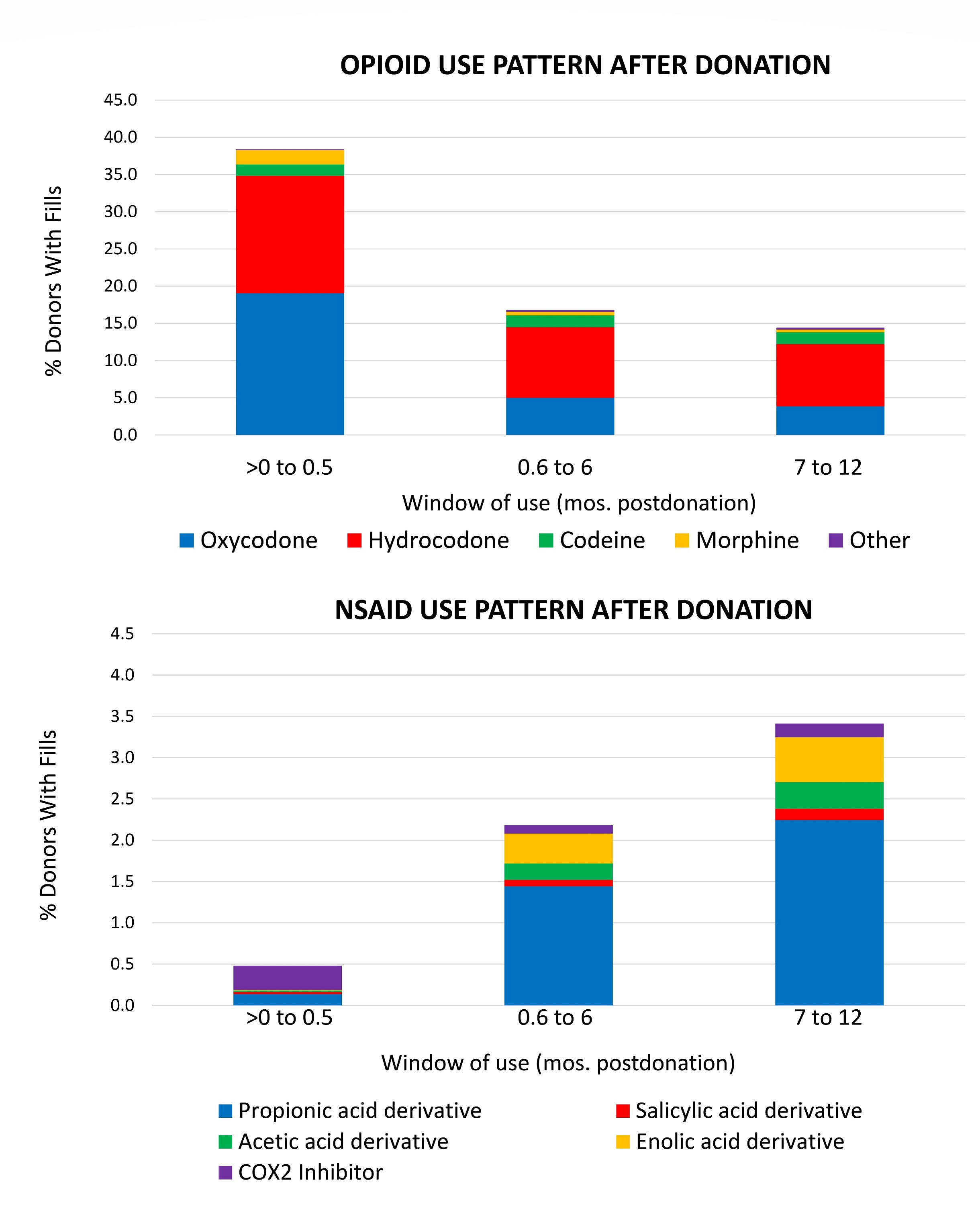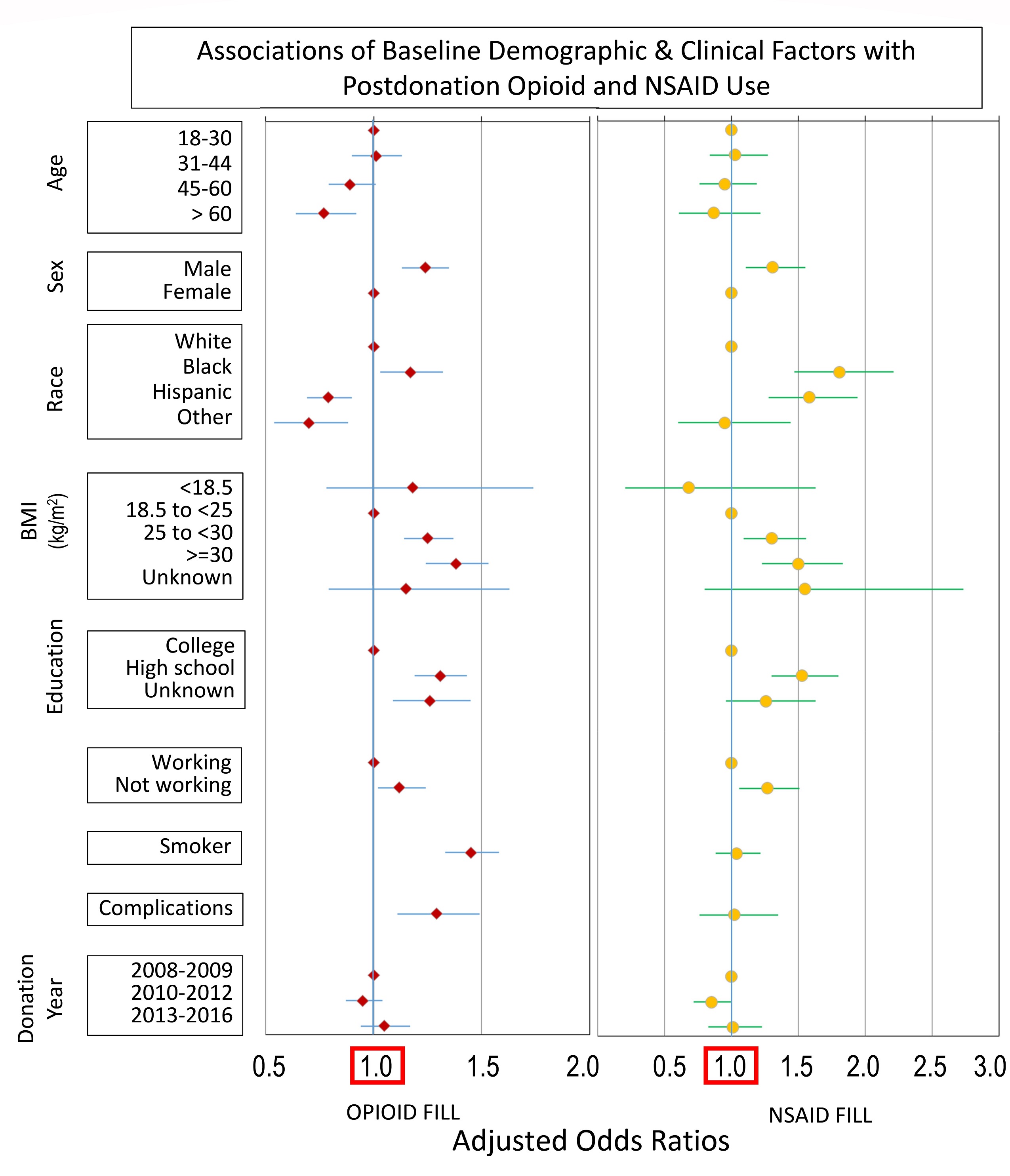Use of Opioids and NSAIDs in Living Kidney Donors: Clinical Correlates and Early Outcomes
1Saint Louis Univ, St. Louis, MO, 2Western Univ, London, ON, Canada, 3Univ of Iowa, Iowa City, IA, 4SRTR, Minneapolis, MN, 5Univ of Pennsylvania, Philadelphia, PA, 6Univ of Michigan, Ann Arbor, MI, 7Johns Hopkins, Baltimore, MD, 8Univ Alberta, Edmonton, AB, Canada
Meeting: 2019 American Transplant Congress
Abstract number: B262
Keywords: Donation, Pain, Proteinuria, Renal function
Session Information
Session Name: Poster Session B: Kidney Living Donor: Quality and Selection
Session Type: Poster Session
Date: Sunday, June 2, 2019
Session Time: 6:00pm-7:00pm
 Presentation Time: 6:00pm-7:00pm
Presentation Time: 6:00pm-7:00pm
Location: Hall C & D
*Purpose: Data are limited regarding pain medication use in living kidney donors (LKD). Concerns relate to opioid use, and to non-steroidal anti-inflammatory (NSAID) use in LKD due to potential nephrotoxicity.
*Methods: We examined a novel database wherein national LKD registry identifiers were linked to records from a large US pharmaceutical claims warehouse (2007-2017 fills). We selected LKD with 1 yr of postdonation fill records. Associations of baseline demographic and clinical factors with opioid and NSAID use (adjusted odds ratio, 95% LCL aHR 95% UCL) were quantified by multivariate logistic regression.
*Results: Among 23,564 eligible LKD, opioid use declined over time postdonation: 36.6%, mos. >0-0.5; 14.7%, mos. 0.6-6; 12.6%, mos. 7-12 (Fig A). NSAID use was uncommon, but increased: 0.5%, mos. >0-0.5; 2.2%, mos. 0.6-6; 3.3%, mos. 7-12. With adjustment including predonation estimated glomerular filtration rate (eGFR), hypertension, donor-recipient relationship and nephrectomy type, opioid use in mos. 7-12 was significantly (P<0.05) associated with female sex (1.131.241.35), black race (1.031.171.32), obesity (1.241.381.53), less than college education (1.191.311.43), not working (1.021.121.24), smoking (1.331.451.58), and surgical complications (1.111.291.49) (Fig B). NSAID use was more common in women, black and Hispanic LKD, obese LKD, and those with lower education, not working, and with surgical complications. Patterns were similar in earlier postdonation periods. Neither opioids nor NSAIDs were associated with eGFR change or proteinuria to 2 years.
*Conclusions: Opioid and NSAID use in LKD varies with demographic and clinical traits. Work is needed to define safety and optimal choice of pain medications in LKD.
To cite this abstract in AMA style:
Lentine K, Vest L, Zhang Z, Koraishy F, Schnitzler M, Garg A, Axelrod D, Kasiske B, Hess G, Naik A, Segev D, Henderson M, Massie A, Lamm N. Use of Opioids and NSAIDs in Living Kidney Donors: Clinical Correlates and Early Outcomes [abstract]. Am J Transplant. 2019; 19 (suppl 3). https://atcmeetingabstracts.com/abstract/use-of-opioids-and-nsaids-in-living-kidney-donors-clinical-correlates-and-early-outcomes/. Accessed December 14, 2025.« Back to 2019 American Transplant Congress


